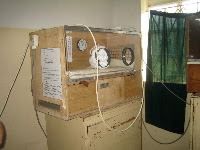



Wednesday morning Mirjam, Lenne and I visited Naggalama hospital. We took a crowded matatu to the hospital, and when we arrived I was very surprised by the grounds. It was spacious, with several small buildings connected together, rather than one huge towering, cumbersome building. We didn’t have an appointment, but we never do, so we had to wait a half hour or 45 minutes to see someone. We interviewed a doctor there about the services they provide, and then we were shown around the maternity wards, the neonatal care unit, and the pediatric ward.
I wish I could have taken photographs of the wards where the patients were laying, but I couldn’t. I did take a few pictures of the neonatal unit, which was empty. It will really shock you, I think. It shocked me, but that doesn’t mean much.
The hospital reminds me of World War I and II movies – iron cots with plastic mattresses, a thin dust in the air. The hospital is open, without screens on the windows, and with few doors. The floors are covered in dusty red footprints and families sleeping on woven mats. The wards are open, with cots evenly spaced; however, the patients' family members and personal belongings consume the space between the beds.
The patients must bring (and launder) their own sheets. They must provide their own food. I have a feeling that families provide most of the care that one would receive in a Western (or at least American) hospital. In one room there was a long table, covered with a plastic mat and on it lay eight babies, whose mothers sat hovering over them. All the babies were receiving intravenous fluids for dehydration.
On the pediatric burn ward, we found four beds. On one of the beds there was something that appeared to be a box covered with blankets. It was actually a wooden cage of sorts, in which a badly burned child was lying. I was not expecting a child to be buried under those blankets and I was not following the conversation, so I didn’t even realize we were on the burn unit. When the mother removed the blankets from the cage (that is too barbaric a word, but I can’t think of a better one to describe it; it was just to keep the child still, and on his back) I felt this surge of despair. I wanted so badly to take a photo because it would have captured suffering without any words. But of course I could not. Nor could I allow my face to betray my complete shock at seeing this child.
I kept thinking of home, and of the sterile isolation rooms where American burn victims recover. Of the pain medicines that would have been coursing through his veins, and the care he would have received if only he had been born on the other side of the world. And this situation returned me to my original purpose here – the realization that all that I have, all that I am, all the potential I have realized and they have not, it’s just geography, and luck. I don’t deserve what I have, and he deserves so much more than he has.
The doctor told us that many burn victims survive, as long as the burns are not too severe. That seems to be the general consensus on survival here – as long as the problem is not too severe, one can survive. For example, this is a large hospital, but they do not have a surgeon on staff. They have only five doctors, who rotate into surgical duties every 3 months. They can really only perform what we would consider minor surgeries. They can do laparotomy “if we have an idea about what the problem is.” They can operate on hernias, and perform C-sections, but that seemed to be the extent of the surgical capacity.
There is a capability for blood transfusion, but only when blood is available. Blood is delivered once weekly, and if a laboring woman hemorrhages (a frequent cause of maternal death in Uganda) she will survive if blood is available. But often it is not. In our survey of health centers, two of the three level 4 centers that should be equipped for blood transfusion were not.
Naggalama had an ultrasound machine but it is now broken. The radiology staff is available Wednesday through Friday. The incubators work, “but they are local.” I don’t know what this means, but upon further questioning, it seems that premature babies survive if the case is not too severe.
Adults and children are treated for HIV/AIDS at no cost. But the doctor was unable to tell us how many patients they serve in that clinic, which means we also don’t know how many they must turn away. But it was promising to hear that treatment is free, and also nice to see “HIV damages the body. People with HIV need care and support.” painted on the side of the wall.
This afternoon we met with the health inspector of our district. He said the main problems in Uganda are poor housing, nutrition, sanitation, and water in the towns and cities. He talked about programs that they have tried, some of which have been successful. He also talked about several that have failed, including efforts to improve toilet and sanitation facilities in the area.
In talking with local leaders like the pastor here, the health inspector, and the head master of the school, everyone points to these same problems. They also mention that people do not know what do with what little money they receive and spend it inappropriately, that people do not understand causes of illness and how sanitation is related to illness, and that once people receive something for free they don’t want to pay for it at a later time. I’m not saying these things are necessarily true, but they are all problems that I have heard mentioned repeatedly.
My container mate Hannah, said she likes the Ugandan lifestyle because it is so easy. And by easy I think she meant easy-going, as in not hurried, scheduled, or stress provoking. After being in the villages it was difficult for me to see life here as easy in any way, but she has been here almost a year, and I’ve been here for two weeks, so what do I know? But to me life here seems very complicated.
It seems that when you want to provide assistance or relief efforts, so many things have to be considered. You have to think about how the government officials will react, and you must invite them to meetings, and engage and woo them. You have to think about whether your efforts are sustainable and what sort of impact they will have. You have to think about whether your efforts and ideas are culturally acceptable. You have to think about sources of water and electricity, and how you will recruit and retain certified staff. You have to think about the fact that it may be better received if a Ugandan runs the program, but they may not have the training required. You have to know if people will use it, and if they will even want it. We may see that they need mosquito nets and improved latrines, but they may want mattresses and blankets. It’s very difficult to navigate these cultural, social, political, and environmental issues.

2 comments:
as always, i have so many questions and i do not know where to begin. i am shattered by your description of the hospital. one question of the top of my head: have you encountered a situation where they abide by the "rumor mill" in their daily practices or in their heathcare? for example, do people think that smearing butter on a burn will aid it in healing? from your comments, it also seems that they suffer from the situation many around the world face--even here in the good 'ol u.s of a. and, that situation is the lack of education. i am not talking solely about university degrees. i am talking bare bones eductaion as well. you (the mass you, that is) cannot expect to give someone a hoe and think that they will know how to dig the earth and plant crops. there has to be education backing that gift. knowledge is power, as they say. love ya, girl.
Another insightful, poingant view of AFrica. I love you my dear, insightful,empathetic, grateful one. J
Post a Comment